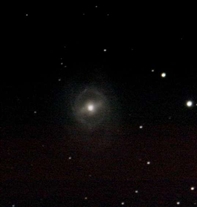m095_45deg_ed80f150_20d-nonr_6x20min800iso_med-ddp1200.jpg
m095_45deg_ed80f150_20d-nonr_6x20min800iso_med-ddp1200.jpg
(m095_45deg_ed80f150_20d-nonr_6x20min800iso_med-ddp1200.jpg)
M95
Orion ED80 f/7.5 with Barlow (f/15.0), canon 20D w/o NR. 6x20min 800iso exposures stacked with Images Plus 2.83. Guided with ST80/DSI2Pro on AP1200 mount.
M95 is a barred spiral galaxy with nearly circular arms surrounding the inner region. It is estimated this galaxy is 38 million lights years away. M95 and M96 are nearly in the same direction in the constellation of Leo and are also neighbors to one another. If you lived in the plane of this galaxy at one end of the bar, you might see your "milky way" look very bright looking along the bar. In our own galaxy, you can see the difference along the plane of the galaxy depending on the direction you look- but the difference is a bit more subtle here. Other barred spiral galaxies in the Messier catalogue include M91, M58 and M109.
M95 was one of the galaxies in the key project of the Hubble Space Telescope for the determination of the Hubble constant: the HST was employed to look for Cepheid variables and thereby determine this galaxy's distance. M95 is a barred spiral of type SBb, or SB(r)ab according to de Vaucouleurs' classification, with nearly circular arms. Alan Sandage, in the Hubble Atlas of Galaxies, calls it a "typical ringed galaxy".
Messier 95
Spiral Galaxy M95 (NGC 3351), type SBb, in Leo
Right Ascension 10 : 44.0 (h:m)
Declination +11 : 42 (deg:m)
Distance 38000 (kly)
Visual Brightness 9.7 (mag)
Apparent Dimension 4.4x3.3 (arc min)
Discovered by Pierre Méchain in 1781.
Excerpt from seds.org:
Messier 95 (M95, NGC 3351) is a beautiful barred spiral galaxy situated in constellation Leo, and one of the fainter Messier Objects.
Pierre Méchain discovered M95, together with M96, March 20, 1781. Consequently, Charles Messier included it in his catalog on March 24, 1781.
M95 is a barred spiral of type SBb, or SB(r)ab according to de Vaucouleurs' classification, with nearly circular arms. Alan Sandage, in the Hubble Atlas of Galaxies, calls it a "typical ringed galaxy". Its overall appearance is quite similar to M91 except that M95 has more pronounced spiral structure.
M95 is a member of the Leo I or M96 group, which also contains M96, M105 and a number of fainter galaxies.
Barred spiral galaxy M95 was one of the galaxies in the key project of the Hubble Space Telescope for the determination of the Hubble constant: the HST was employed to look for Cepheid variables and thereby determine this galaxy's distance. A preliminary result has been obtained and published in 1996-97 by the HST H0 Key Project Team (paper VII, 1997). Their result, corrected for the semi-recent adjustment of the Cepheid brightness zero point by ESA's Hipparcos astrometrical satellite, is a distance of 35.5+-3.1 million light years. This is in semi-good agreement with the value of about 41 million light years (after correction for Hipparcos results) which had been obtained earlier by Nial R. Tanvir for its neighbor M96, and implies a distance of all the galaxies in the Leo I group of about 38 million light years.
